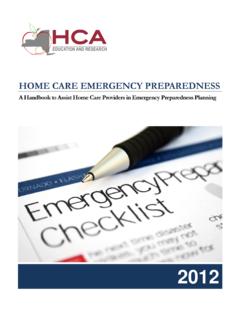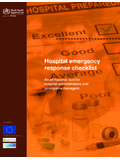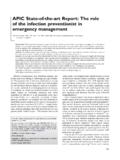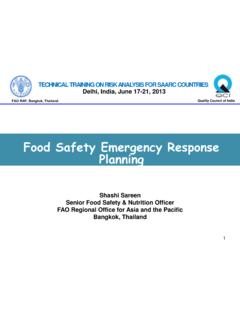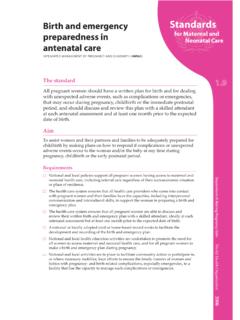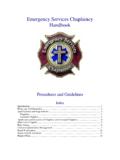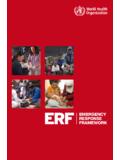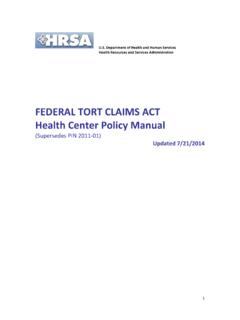Transcription of Fire Safety and Emergency Guidelines - Connecticut
1 DANNEL P. MALLOY GOVERNOR fire Safety and Emergency Guidelines STATE OF Connecticut DEPARTMENT OF DEVELOPMENTAL SERVICES TERRENCE MACY COMMISSIONER JOSEPH DREXLER DEPUTY COMMISSIONER email- Issued March,2004 Reviewed and Revised 7/09 Reissued August, 2009 DDS fire Safety & Emergency Guidelines Issued : 3/04 Reissued 8/09 2 STATE OF Connecticut DEPARTMENT OF DEVELOPMENTAL SERVICES fire Safety AND Emergency Guidelines TABLE OF CONTENTS INTRODUCTION .. Page 3 Page 4 PART I DDS GENERAL fire Safety AND Emergency Guidelines Chapter 1. fire Emergencies: General Page 6 Chapter 2. fire Emergencies: Dealing with fire Emergencies .. Page 7 Chapter 3. Other Types of Emergencies: General 10 Chapter 4.
2 Other Types of Emergencies: Specific External 11 Chapter 5. Other Types of Emergencies: Specific Hazards within the 13 Chapter 6. fire Prevention: General 15 Chapter 7. fire Prevention: Building fire Protection 16 Chapter 8. fire Prevention: General fire Safety 19 Chapter 9. fire Prevention: fire Evacuation 23 Chapter 10. Developing Community Relationships for 27 Chapter 11.. Page 28 PART II SITE SPECIFIC fire Safety AND Emergency PLANS Chapter 1. Overview of Site Specific fire Safety and Emergency Page 31 Chapter 2. Minimum Contents of a Site Specific fire Safety and Emergency Plan for CLA s, Campus, Community Training Homes and Day Service and Support .. Page 32 Chapter 3. Minimum Contents of a Site Specific fire Safety and Emergency Plan for Individual Supports, Own Homes and Family .. Page 33 Chapter 4. Minimum Contents of a Site Specific fire Safety and Emergency Plan for Respite.
3 Page 34 PART III ANNEXES 1) DDS GENERAL fire Safety AND Emergency Guidelines SUPPLEMENTAL MATERIAL a) Condensed fire Safety and Emergency Guidelines supplemental Material 2) DDS fire Drill Form 3) Evacuation Score Frequently Asked Questions 4) FILL IN THE BLANK TEMPLATES FOR SITE SPECIFIC PLANS: a) CLA s, Campus/Respite Programs, Community Training Homes and Day Programs b) Supported Living and Family Homes 5) fire Safety AND Emergency Guidelines FOR INDIVIDUAL & FAMILY HOMES 6) FILE FOR LIFE 7) fire PROTECTION EQUIPMENT AND TESTING AND MAINTENANCE Guidelines 8) OTHER RESOURCES 9) RESOURCES FOR FAMILY HOMES 10) fire PLAN FOR FAMILY RESPITE CENTERS DDS fire Safety & Emergency Guidelines Issued : 3/04 Reissued 8/09 3 INTRODUCTION Since March 2004, the Department of Developmental Services (DDS) fire Safety and Emergency Guidelines have served as a summary of best practices , supporting Commissioner Peter O Meara s health and Safety agenda.
4 This important reference document is, furthermore, an All Hazards Guidebook for consumers, families, and support staff. These Guidelines , first published in 2004 and revised in 2005, are reissued in this 2009 edition, which is the basis for DDS s fire Prevention Training Curriculum, for which the Department was awarded a development grant by the Department of Homeland Security, Emergency Preparedness and Response Directorate, under the Assistance to Firefighters Grant- fire Prevention and Safety Program. In July 2008, a curriculum development committee was formed to review and revise the Guidelines . A cross section of individuals representing the fire service community, private providers, DDS staff and consumers, met through the Fall and completed these revised fire Safety and Emergency Guidelines . This project was completed by Co-Committee Chairs, Timothy E. Baldwin, fire Chief, DDS Southbury Training School fire Department and Daniel A.
5 Micari, DDS Director of Quality Management Services Division, along with Committee members Adam Piskura, State Director of fire Training, Commission on fire Prevention and Control; Russ Emons, Director of Public fire Education, Commission on fire Prevention and Control; Alan Zygmunt, Public fire and Life Safety Coordinator, Connecticut fire Academy; Carlos M. Colon, DDS Self Advocate Coordinator; Kenneth Comerford, DDS Quality Services Review Specialist Supervisor; Elmer Kiessling, Department of Pubic Safety , Division of fire Emergency and Building Services, Office of the State fire Marshal; Maureen Evelyn, DDS Trainer; Cathy Faulkner, DDS Regional Training Supervisor; John Yacovino, Connecticut fire Marshals Association; Irving D. Moy, Public Health Services Manager, Department of Public Health; Carmen Onalfo, DDS Quality Services Review Specialist Supervisor; Christine Pratt, fire Lieutenant, DDS Southbury Training School; Stan Soby, Vice President of Community Programs, Oak Hill School for the Blind; Stella Stanescu, Executive Director, Network, Incorporated; John D.
6 Tierney, DDS Program Training Coordinator; Beverly Tulisano, DDS Public Community Programs Manager; Robin Wood, DDS Self Determination Director. These Guidelines are intended to advance awareness and educate all of the stakeholders whose daily health and wellbeing depend on a practical understanding of the dangers of fire and other hazardous emergencies. The Guidelines furthermore promote vigilance and readiness on the part of every one of us who face the possibility of an unforeseen Emergency , which may require a life sustaining response for ourselves, or others who depend on assistance or support. Many thanks to the committee whose work will serve as the foundation for awareness, prevention, and readiness at home, at work, and in our communities DDS fire Safety & Emergency Guidelines Issued : 3/04 Reissued 8/09 4 FORWARD The State of Connecticut DEPARTMENT OF DEVELOPMENTAL SERVICES (DDS) has always maintained an aggressive campaign in dealing with the ever-present threat of fire or other emergencies.
7 Full compliance with all State, Federal and other regulatory agencies codes and regulations pertaining to fire and emergencies has always been a cornerstone of the Department s approach toward fire Safety . These Guidelines are promulgated, to provide guidance and direction in assisting those charged with providing services to individuals served by DDS. These Guidelines provide a holistic approach to fire Safety , fire prevention and all hazard response. It addresses not only meeting minimum standards set forth by regulatory agencies, but also addresses general building construction features, planning and preparation for response to emergencies, fire prevention, training for both staff and consumers, and integrates all these facets of Safety into one easy to use guideline. Therefore these fire Safety and Emergency Guidelines are divided into Three Parts: PART I DDS fire Safety AND Emergency Guidelines DEALING WITH EMERGENCIES Provides general instructions and Guidelines that should be used throughout DDS, on how to respond to fire , potential fires (automatic alarms), internal and external hazards.
8 fire PREVENTION Guidelines Provides general information on building fire protection features, general fire Safety practices and Guidelines to conducting fire evacuation drills. Also provides resources for developing community relationships for Safety . PART II SITE SPECIFIC fire Safety AND Emergency PLANS Overview of what Site Specific fire Safety and Emergency Plans are and also provides minimum contents of Site Specific fire Safety and Emergency Plans for various occupancies and programs. NOTE: See the Annexes for Fill in the Blank Templates for Site Specific Plans PART III ANNEXES These annexes constitute a living document , which can be updated with new information to enhance or develop these documents for future use. OTHER IMPORTANT INFORMATION Providers should also develop plans and procedures to adequately: Train all staff in these Guidelines and Emergency procedures, and Train individuals, to the best of their ability, in Emergency procedures.
9 DDS fire Safety & Emergency Guidelines Issued : 3/04 Reissued 8/09 5 PART I - DDS GENERAL fire Safety AND Emergency Guidelines What to do in fire Emergencies DDS fire Safety & Emergency Guidelines Issued : 3/04 Reissued 8/09 6 Chapter 1- fire Emergencies: General Instructions Despite everyone s most conscientious efforts, fire and other Emergency situations may occur. It is important to have appropriate planning, training and skill to be ready and able to react effectively. The training and information you receive is designed to help prepare you so that if an incident does occur, your response should be immediate, intelligent and most importantly, effective. The following instructions need to be followed throughout the DEPARTMENT OF DEVELOPMENTAL SERVICES for all fire Emergencies ( , fire , smoke, odor of smoke or burning, crackling noises, unusual heat conditions, and any automatic detector activation).
10 Although specifically geared to fire type emergencies, much of this would apply in any generalized Emergency situation. In addition, following this section on dealing with fire emergencies, there is some specific guidance for dealing with other potential emergencies. GENERAL INFORMATION : 1. ALL AUTOMATIC ALARMS shall be treated as TRUE EMERGENCIES. Everyone should immediately implement the fire Plan and begin an evacuation as outlined in your evacuation plan, regardless of the cause of the automatic alarm. 2. ANY Staff members and any other occupants in the building(s) at the time of an alarm or other Emergency shall render such assistance as directed. 3. Beds, mattresses and other bulky equipment should NEVER be used to evacuate occupants unless absolutely necessary. (Use blanket drags, carries, etc.) 4. STAY LOW.










